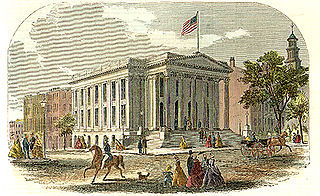
The imperial system of units, imperial system or imperial units is the system of units first defined in the British Weights and Measures Act 1824 and continued to be developed through a series of Weights and Measures Acts and amendments.

Metrication or metrification is the act or process of converting to the metric system of measurement. All over the world, countries have transitioned from local and traditional units of measurement to the metric system. This process began in France during the 1790s, and has persistently advanced over two centuries, accumulating into 95% of the world officially only using the modern metric system. Nonetheless, this also highlights that certain countries and sectors are either still transitioning or have chosen not to fully adopt the metric system.

United States customary units form a system of measurement units commonly used in the United States and most U.S. territories, since being standardized and adopted in 1832. The United States customary system developed from English units that were in use in the British Empire before the U.S. became an independent country. The United Kingdom's system of measures was overhauled in 1824 to create the imperial system, which was officially adopted in 1826, changing the definitions of some of its units. Consequently, while many U.S. units are essentially similar to their imperial counterparts, there are noticeable differences between the systems.

Metrication is the process of introducing the International System of Units, also known as SI units or the metric system, to replace a jurisdiction's traditional measuring units. U.S. customary units have been defined in terms of metric units since the 19th century, and the SI has been the "preferred system of weights and measures for United States trade and commerce" since 1975 according to United States law. However, conversion was not mandatory and many industries chose not to convert, and U.S. customary units remain in common use in many industries as well as in governmental use. There is government policy and metric (SI) program to implement and assist with metrication, however there is major social resistance for further metrication.

The United States Metric Board (USMB) was a United States government agency set up to encourage metrication. The United States Metric Board was commissioned by the Metric Conversion Act of 1975. The Metric Conversion Act of 1975 mandated the presidential appointment of seventeen members for the "independent instrumentality".

Franklyn Curran "Lyn" Nofziger was an American journalist, conservative Republican political consultant and author. He served as press secretary in Ronald Reagan's administration as Governor of California, and as a White House advisor during the Richard Nixon administration and again during the Reagan presidency.

The US Metric Association (USMA), based in Windsor, Colorado, is a non-profit organization that advocates for total conversion of the United States to the International System of Units (SI). Founded on 27 December 1916 at Columbia University in New York City, it was originally called the American Metric Association. The USMA publishes a bi-monthly newsletter for its members on the state of the metric system in the United States called Metric Today.

The Global Change Research Act 1990 is a United States law requiring research into global warming and related issues. It requires a report to Congress every four years on the environmental, economic, health and safety consequences of climate change.
The spread of metrication around the world in the last two centuries has been met with both support and opposition.

The Housing and Community Development Act of 1974 is a United States federal law that, among other provisions, amended the Housing Act of 1937 to create Section 8 housing, authorizes "Entitlement Communities Grants" to be awarded by the United States Department of Housing and Urban Development, and created the National Institute of Building Sciences. Under Section 810 of the Act the first federal Urban Homesteading program was created.

The Arms Export Control Act of 1976 gives the President of the United States the authority to control the import and export of defense articles and defense services. The H.R. 13680 legislation was passed by the 94th Congressional session and enacted into law by the 38th President of the United States Gerald R. Ford on June 30, 1976.

The Indochina Migration and Refugee Assistance Act, passed on May 23, 1975, under President Gerald Ford, was a response to the Fall of Saigon and the end of the Vietnam War. Under this act, approximately 130,000 refugees from South Vietnam, Laos and Cambodia were allowed to enter the United States under a special status, and the act allotted special relocation aid and financial assistance.

The imperial and US customary measurement systems are both derived from an earlier English system of measurement which in turn can be traced back to Ancient Roman units of measurement, and Carolingian and Saxon units of measure.

Former Soviet Union Demilitarization Act of 1992, 22 U.S.C. ch. 68 §§ 5901-5931, is a United States Federal law created to coordinate disarmament efforts with the former Soviet Union. The Act, better known as the National Defense Authorization Act for Fiscal Year 1993, provided legislative authority for the United States Department of Defense supporting armament retooling, chemical demilitarization, and nonproliferation initiatives.

Aviation Drug-Trafficking Control Act of 1984 is a United States Federal law amending the Federal Aviation Act of 1958. The statutory law authorized criminal penalties for the unlawful aerial transportation of controlled substances. The Act of Congress mandated the revocation of aircraft registrations and airman certificates by the Federal Aviation Administration whereas an aircraft aviator knowingly engages in the transit of illicitly used drugs. The Act established authority and a statute of limitations for the reissuance of airman certificates by the United States Secretary of Transportation.

Helium Act of 1925, 50 USC § 161, is a United States statute drafted for the purpose of conservation, exploration, and procurement of helium gas. The Act of Congress authorized the condemnation, lease, or purchase of acquired lands bearing the potential of producing helium gas. It banned the export of helium, for which the US was the only important source, thus forcing foreign airships to use hydrogen lift gas. The Act empowered the United States Department of the Interior and United States Bureau of Mines with the jurisdiction for the experimentation, production, repurification, and research of the lighter than air gas. The Title 50 codified law provided the authority for the creation of the National Helium Reserve.

The Land Remote-Sensing Commercialization Act of 1984 is a United States statute establishing a system to further the utilization of satellite imagery data obtained from Earth observation satellites located in a geocentric orbit above the atmosphere of Earth.

La Follette–Bulwinkle Act or Venereal Diseases Control and Prevention Act of 1938 sanctioned federal assistance to U.S. states establishing preventive healthcare for venereal diseases. The United States federal statute commissioned the United States Public Health Service for demonstrations, investigations, and studies as related to the control, prevention, and treatment of opportunistic infections. The public law amended the Army Appropriations Act of 1918 appending the judicial context which created the Division of Venereal Diseases within the Bureau of the Public Health Service.

Abandoned Barge Act of 1992, known as the Oceans Act of 1992, is United States federal law prohibiting the abandonment of barges in navigable and territorial waters. The Act of Congress establishes financial penalties and removal procedures for unattended barges exceeding forty-five days. The federal statute provides the U.S. Secretary of Transportation authority to contract with barge removal contractors for abandoned barges of more than one hundred gross tons.

Earthquake Hazards Reduction Act of 1977 is a statute formulating a national policy to diminish the perils of earthquakes in the United States. The Act of Congress is a declaration for an earthquake prediction system, national earthquake hazards reduction program, and seismological research studies. The United States public law authorizes States assistance through the provisions of the Disaster Relief Act of 1974.









